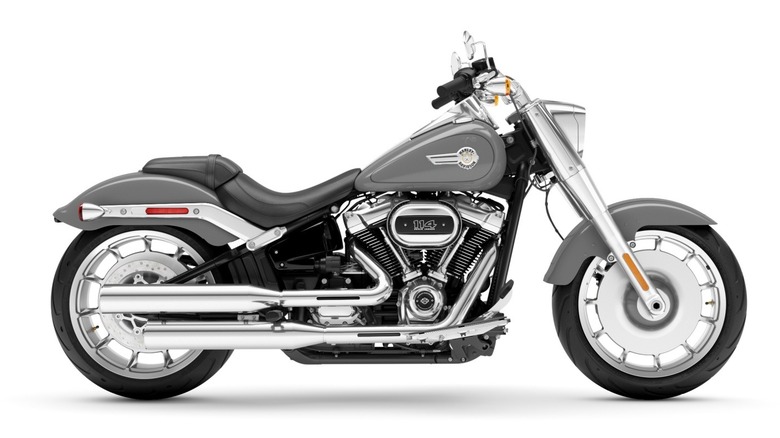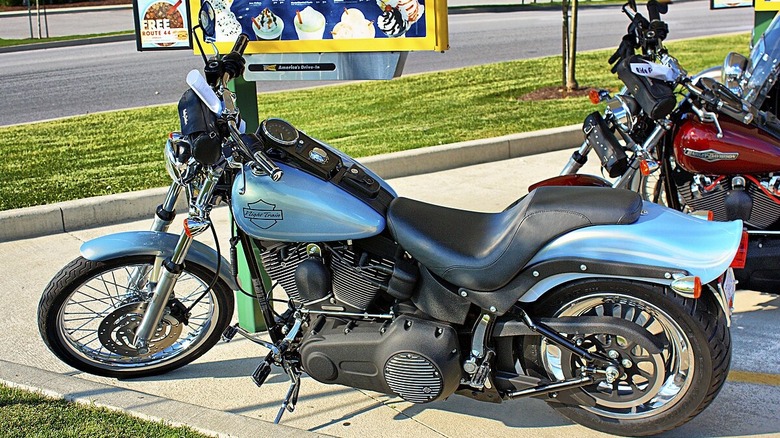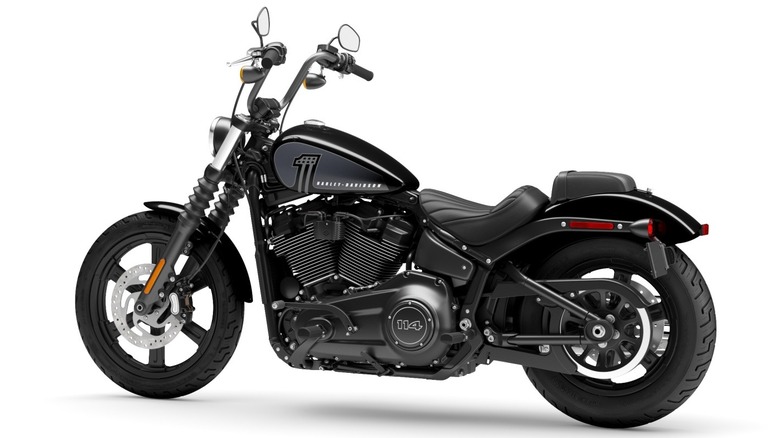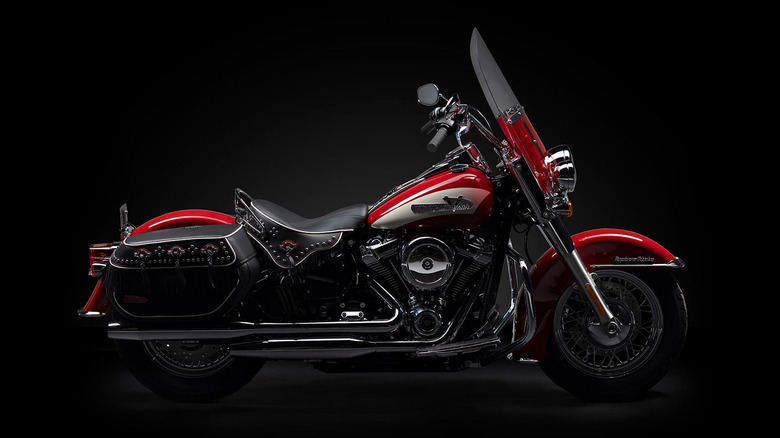8 Of The Best Harley-Davidson Softails Ever Built
Harley-Davidson is one of the world's oldest continuously operating motorcycle builders. Founded in 1903 in a backyard shed in Milwaukee, Wisconsin, Harley is fiercely traditional, always distinctive, and often polarizing. By defining a nation's vision for motorcycling for over 120 years, Harley has built some incredible (and admittedly, not-so-incredible) motorcycles.
With a history nearly as long as that of the automobile itself, Harley-Davidson can't be expected to hit every ball out of the park. Despite being accused by detractors of clinging to old-fashioned ways, Harley has consistently sought to upgrade and update its engines throughout its storied history. There have been flops and failures, but also incredible successes.
One of those success stories begins in 1984. Three years earlier, Harley-Davidson had been bought back from American Machine and Foundry (AMF). With the company suffering from a bad reputation stemming from poor build quality and reliability issues, new ownership wanted some victories to regain some of the cachet that Harley had enjoyed in better years.
The Harley-Davidson Softail appeared in 1984 as one of the first models to get the Evolution engine. Inspired by home customization made popular during the 1970s, the first Softail might have looked to the past, but it also had an eye on the future. In honor of over four decades in the Harley lineup, we examine some of the best Harley-Davidson Softails ever built.
What is a Softail?
The motorcycle customization trend sparked after World War II roared into life in the 1970s and 1980s. Amateur gearheads and professional mechanics took to garages to weld, paint, chop, and modify factory motorcycles into rolling art pieces. The word "chopper" — slang for a motorcycle with a raked front end — entered the lexicon, boosted by pop culture in films like 1969's Easy Rider.
Choppers were typically built using motorcycles with rigid frames. Known affectionately (or derisively) as "kidney busters," these hardtail motorcycles offered no rear suspension, making them uncomfortable to ride but nifty to look at.
Fresh out of the AMF debacle and armed with one of the best Harley-Davidson engines ever made, the Evolution, Harley wanted to seize on the popularity of the hardtail look and chopper trend. Its answer: the Softail.
The first Softail appeared for the 1984 model year with an ace up its sleeve. Hidden under the seat, a cantilever rear suspension provided a softer ride while retaining the distinctive look of a hardtail frame.
The Softail, combined with the reliable and powerful Evolution engine, proved an instant success. It was the best of both worlds: old-school cool looks with modern comfort and reliability, a customizable chopper waiting for riders to add their personal touches or enjoy out of the box.
In the 40 years since, Harley has used the Softail formula to build some of the most beloved and beautiful models of all time.
[Featured image by Rooster via Wikimedia Commons | Cropped and scaled | CC BY-SA 3.0]
Fat Boy
An early Softail that showed up for the 1990 model year, the Fat Boy has earned a name for simple, elegant styling and cruiser capability. A member of our list of best Harley-Davidsons ever made, the Fat Boy is still in rotation in 2024.
Willie G. Davidson (yes, of that Davidson family) was part of the AMF buyback effort in 1981. With the company in good hands and slowly rebuilding its reputation, he launched a pet project in the late 1980s. Designed with Louie Netz, the soon-to-be-famous Harley-Davidson Fat Boy, had to be perfect. Davidson demanded extensive testing before the bike went public, even personally riding it to Daytona in 1988 and 1989 before its debut.
Aside from the trademarked Softail rear end, the Fat Boy was a muscle cruiser with an 82 cubic inch (1,337 cc) 45-degree V-twin engine making 67 horsepower at 6000 RPM. The year after its debut, a 1991 model appeared on the big screen beneath Arnold Schwarzenegger in Terminator 2. While the real deal likely wouldn't survive the jump into the dry river bed it undertook in the film, it proved a robust and popular model.
The Fat Boy grew over the years. Originally named for its wide dimensions, the 2024 model has grown into its nickname. Now, with a beefy 114 ci (1,868 cc) Milwaukee-Eight engine making an estimated 94 horsepower at a grunty 4,750 RPM, it retains the timeless look and popularity of the original thrust into the 21st century.
Heritage Classic
With a lineage as long as Harley-Davidson's, it should be little surprise that heritage is at the forefront of some of its marketing strategies. The Softail got the legacy treatment in the Softail Heritage Classic, which featured design cues and themes of classic motorcycles combined with modern performance and comfort.
With the original Softail FXST filling the commuter and around-town cruiser role, Harley set the Heritage up as a light bagger. Bare bones by today's standards, the original iteration has seen tons of upgrades over the years. Like the Fat Boy, it has enjoyed continuous production, including a 2024 model with the 114 ci Milwaukee Eight that represents the most modern Harley has to offer.
Despite its vintage inspiration, the Heritage Softail Classic is far from a relic. It pays homage to the classic bikes of yesteryear, but with a feature-laden 2024 model already on the streets, it's no antique.
Unlike the leather and metal-studded bikes of the past, the Heritage Softail Classic boasts features like ABS, detachable windscreen, LEDs, and a powerful 94-horsepower engine, bringing the best of both worlds to the modern rider.
The Heritage Softail Classic, with its timeless design and modern features, continues to be a top choice for Harley enthusiasts who enjoy weekend trips or extended cruises. Its enduring popularity and place in the Harley line make it one of the best Softails to carry the name.
Crossbones
Harley-Davidsons are known for chrome gleaming from every possible part and accessory, but Harley designers turned that convention on its head in the mid-aughts. The Dark Custom line took Harley down a shadowed path in terms of design, as evidenced by the Crossbones model introduced in 2008.
The Dark Custom line flagship was all bobber design and dark paint schemes splashed with just a dash of chrome. Embracing the outlaw look with a Jolly Roger on the oil tank and a black powder-coated powertrain, it stood out from other bikes with its unique design and menacing mug. With a sprung solo seat and a springer front end, it was a bike for a lone ranger who cared not for the pitiful conventions of society. Or an accountant who liked to ride to and from work. Either way, it still stands out years after it went out of production.
A 96B V-twin with a displacement of 1,584 cc proved to be the heart of the Crossbones. Horsepower numbers are tough to come by, but the 700-pound bike made 94 lb-ft of torque at 3,000 RPM. With low-end power like that, it was a great homage to the post-WWII custom bikes that inspired it.
Unlike the first two entries on this list, the Crossbones didn't survive long. Harley discontinued the model in 2012 due to shifting consumer desires and poor sales. Still, it gets a place on our list for its raw rebellion, intriguing aesthetics, and badass brutality on the street.
2006 to 2009 Night Train
An early adopter of the dark look, the Softail Night Train arrived in 1998 with the not-so-fondly remembered Twin Cam 88 engine. The 88 had plastic cam chain tensioners that tended to shred into the oil pump, destroying the engine. While some Harley owners have reported few problems with the 88, if you're in the market, you may want to steer toward the 2006 to 2009 Night Trains, as they got the upgraded 96 Twin Cam.
The Night Train had an all-black powertrain meant to introduce the European market to the wonders of custom motorcycling. Relatively inexpensive (for a Harley), it looked custom with clean lines, drag bars, and a nice mix of black powder coat and chrome.
Making 63 horsepower, it wasn't the most powerful bike in the world, but it was understated, simple, and provided a way to get as close to the core of the riding as possible. It also earned points for style with a long, lean, and low profile.
The Night Train, while not designed for sharp handling, weighs over 650 pounds. Equipped with a single disc for the front and rear braking system, it was not for the knee-draggers. But it excels at turning heads around town with its distinctive design and sonorous exhaust.
[Featured image by John Schanlaub via Wikimedia Commons | Cropped and scaled | CC BY-SA 4.0]
Breakout
The Breakout, a muscle cruiser in the distinctive Harley style, made its debut in 2013. Its Twin Cam 103 cubic inch (1,690 cc) engine and six-speed transmission exude a unique blend of power and style. Its low profile and long rake on the front wheel give it a chopper appeal straight from the factory.
Harley-Davidson and muscle cars share fans for a reason. Throaty, simple engines, oodles of torque, and a stance that suggests a predator on the verge of pouncing are timeless qualities. The Breakout is one of the recent Harleys that deliver these characteristics.
Harley offered an array of customization options for the Breakout, so the used market is littered with unique bikes. With a massive 240 mm rear tire putting tons of torque to the ground, it's a no-holds-barred muscle bike with tons of style.
Harley continued to upgrade the Breakout between 2013 and 2020 when it temporarily ceased selling in the American market. By then, the CVO edition had a 110 ci Screamin' Eagle Twin Cam engine, putting down 122 lb-ft of torque at 3,500 RPM.
The Breakout returned to the U.S. with the new Milwaukee Eight 117 ci engine, only the third Softail model to get it after the Low Rider S and Low Rider ST. The Breakout was available for 2024, so scoring a brand-new one is still within the realm of possibility.
[Featured image by Lothar Spurzem via Wikimedia Commons | Cropped and scaled | CC BY-SA 2.0 DE]
2018 onward Street Bob
The Street Bob, a symbol of Heritage style in a stripped-down form, has a rich history. Since its inception in 2006, it has been a member of the Dyna family, easily distinguishable from the Softails by the visible springs in the rear suspension. However, when Harley-Davidson discontinued the Dyna line in 2017, the Street Bob transitioned to the Softail family.
The Street Bob has always been a minimalist motorcycle with a nod to modern comfort. One of the most popular models Harley built as a Dyna, it plunged into its Softail life in 2018 with some upgrades and a new profile. The 2018 Street Bob got the Milwaukee Eight engine in a 107 cubic-inch form, but Harley upped the displacement through the years. The 2024 Harley-Davidson Street Bob got the 114 cubic-inch engine.
The Street Bob, despite its lightweight design for a Softail at 655 pounds, packs a punch with its 94 hp and 119 lb-ft of torque. While optional ABS provides additional braking security, it's not a standard feature. Those seeking the ultimate in modern long-distance comfort might do well to seek out a Heritage. The Street Bob is what it sounds like: a bobber-inspired street bike.
Harley's focus on eliminating unnecessary elements ensures that the Street Bob delivers a pure riding experience, free from distractions, while still performing all the essential functions of a motorcycle.
Hydra-Glide Revival
For die-hard fans of classic Harleys, the 75th-anniversary edition of the Hydra-Glide is a must-see. If you're a fan of Heritage Classics or the older Springer Softails, the Hydra-Glide Revival, with its unique features, is definitely worth a look.
Harley-Davidson sought to capitalize on its extensive history and iconic motorcycles by launching the Icons line in 2021. The latest flagship of the line, the Hydra-Glide Revival, is chock full of the retro charm of the 1950s-era Hydra-Glides – specifically the 1956 FLH – with a sackful of modern amenities.
Despite its vintage appearance with whitewall tires, a raised solo seat, and a classic paint scheme, the Hydra-Glide Revival is far from old-school. The 74 cubic-inch displacement of the '50s motor has been replaced with the modern Milwaukee Eight 114 cubic-inch V-twin, and the upgrades don't stop there.
The Revival doesn't just offer a modern suspension that far surpasses the vintage FLH. It's also a powerhouse, with 94 hp and 119 lb-ft of torque, making it perfect for cruising around town or embarking on long road trips.
Everything about the limited edition Hydra-Glide Revival screams homage to the glory of yesteryear combined into a modern package. There's nothing better for a particular sort of Harley aficionado.
Softail Standard
Harley isn't known for affordability, and prices only go up as bikes get bigger and badder. The Softail Standard is the least expensive way to join the Softail family. With understated styling and the Softail look, the new option has everything riders need to enjoy the open road.
The limited paint options of Vivid Black or Billiard Gray reflect most of what Harley is trying to convey with the stripped-down yet competent Softail Standard. A Milwaukee-Eight 107 cubic inch powerplant, mid-mount foot controls, a low seat height, and manageable weight combine to make the Softail Standard the first and last Harley you'd ever need to own.
The Softail Standard embodies the spirit of the original 1984 vision of the Softail. Its classic rigid frame, bare-bones charm, and unmistakable Harley style make it a great choice for anyone looking to join the Harley community. Priced at $14,999, it may not be the cheapest option compared to sport-cruising competitors, but it certainly holds its own in the Harley price hierarchy.
Whether it's the Softail Standard or another model that ignites your passion, rest assured that Harley has been crafting these bikes since 1984, and there's no sign of them stopping anytime soon.









